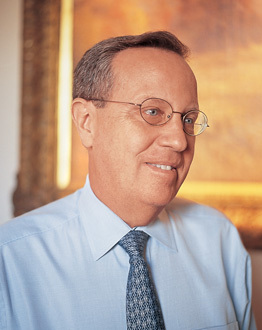 loading
loading
Q&A: Rick LevinWhere the art isAn interview with Yale president Rick Levin ’74PhD  Mark OstowView full imageY: Ever since Yale acquired the West Campus from Bayer, most of the attention has focused on what Yale plans for the state-of-the-art science facilities it now owns there. But you have plans for the arts, as well. L: The West Campus offers some great opportunities for the arts. The first would be as a site for collections storage that is more browsable and usable. We have a large manufacturing plant there and a very large warehouse, half of which has pretty good temperature control. Y: Which collections will have storage there? Not only the Art Gallery and the Center for British Art, but also the Peabody and the library? L: The plan for the West Campus embraces the three major museums and the library. We're already moving parts of the Peabody's collections currently stored in the basement of 175 Whitney -- the anthropological collections. Because we have an off-site shelving facility for the library in Hamden [north of New Haven], we probably won't -- in the near term, the next ten or fifteen years -- use the West Campus for shelving. However, we are thinking about creating a processing center for incoming library materials, rather than continue to do that on the first floor of Sterling Library. There's a beautiful area there that is now carved up into workspaces. It could become another grand reading room. We are also thinking about using some of the large open warehouse space on the West Campus for multidisciplinary uses in the creative arts -- where the art school might do sculptural installations, or the drama school might stage an event with unconventional set design, or architects might build large-scale models. Another idea is to do something that brings together all the collections and extends to a point of contact with the scientists who will also occupy the West Campus. The thought is to create a first-rate conservation lab on the West Campus that will work with all of our collections. Ian McClure, a world-renowned conservator who recently came to Yale, has leadership on this project. He and his colleagues hope to build a first-rate conservation program that will serve our libraries and museums but also offer a master's degree in conservation. Y: What then happens to the existing conservation spaces on the main campus? L: There will still be some need for on-site conservation space. There are times when the faculty in art history want to show students how conservation is done, and that's best located on the main campus. In general, our art museums have come to play a very important role in education. A number of courses meet in the museums, and many more make use of them to permit the close study of objects. And at the Center for British Art and at the Beinecke Library, students have opportunities to work with rare manuscripts. Y: When I took history courses at Yale 30 years ago, we never got near the artifacts. L: Both Jock Reynolds and Amy Meyers [directors of the Art Gallery and Center for British Art] have worked hard to develop a stronger connection to the faculty. And the other way the museums teach is through exhibitions. Many of the exhibitions at Yale are not the kind you see at the Metropolitan or other major public museums, because they are developed with an educational purpose in mind. The current exhibition at the Art Gallery on conservation is a great illustration of this point. The exhibit highlights a series of examples to illustrate hard choices in conservation. You see the objects, and you have a very didactic explanation of the decisions confronting conservators, and you can visualize them for yourself. To varnish or not to varnish? What do you do with a Roman sculpture that was Or consider the Picasso exhibition the Art Gallery organized this spring, with the theme “Picasso and the Allure of Language” -- a very scholarly exhibition that brought together not only the basic collection of Picassos we have here at Yale, but also many drawings and illuminated manuscripts that Picasso did with major poets. And this year the Center for British Art mounted a major exhibition in honor of Darwin's bicentennial, about the influence that Darwin's thought had on late-nineteenth-century art. These types of exhibitions are typically put together by a combination of curators at the art galleries and faculty members. Students participate, too, as research assistants and helpers. Y: At what level is the coordination worked out? L: Partly, it's the personality of the people who have leadership positions. Jock Reynolds and Amy Meyers are both strong advocates of using the collections for educational purposes. Today, there is much more collaboration between art history professors and the curators at the galleries and museums. Many of the curators teach regularly and do significant scholarship. Larry Kanter, for example, is a curator of early European art, but he is also a distinguished scholar. And Tim Barringer is a tenured professor of the history of art, but he has curated important exhibitions. Tim teaches his classes right in the British art center -- sitting in the middle of the galleries. He feels that's the right environment for his students. We are incredibly fortunate to have such magnificent collections and faculty, curators, and librarians who appreciate them.
The comment period has expired.
|
|